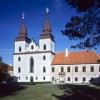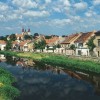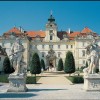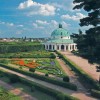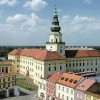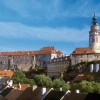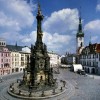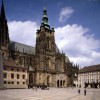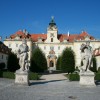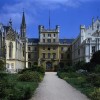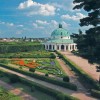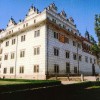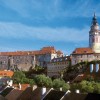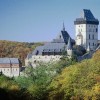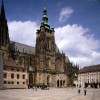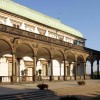All Czech rivers have their own unforgettable charm. The Berounka runs gently and quietly through forested valleys and is ideal for beginners and families with children. The rapids of the Sázava will give water sportsmen a hard time and test the skills of both rowers to manoeuvre the boat among the rocks. The longest Czech river, the Vltava, also has numerous rapids. Lovers of unspoilt countryside will appreciate its upper reaches flowing through the Šumava National Park. But which river is the right one for a summer trip in search of adventure and romance?
This question was answered in a questionnaire prepared by the CzechTourism agency on the portal www.tipsfortrips.cz. Readers voted in the poll from 20 July to 6 August 2010 and in doing so compiled a ranked list of the most popular Czech rivers for water sports enthusiasts. The Sázava, voted for by 30% of the 1,370 voters, won by a landslide as it took the title of most romantic Czech river. The Berounka, a fixed star among popular touristic rivers, placed second with 22% of the vote, while the Vltava surprisingly lagged far behind those water sports hits with only 9%.
1. Sázava – the most romantic Czech river
The Sázava is a permanent fixture of summer canoeing, rafting and kayaking, with difficulty levels suitable for all paddlers. The challenging Stvořidla rapids rage on the upper stream, giving way to calmer waters with romantic creeks well-suited for a summer dip. Navigating the river is facilitated by weirs with sluices, which make the journey more exciting. The popular section between Týnec nad Vltavou and Pikovice was selected by readers as the most beautiful stretch of the Sázava. This section is well-known for its many beautiful, long rapids of varying difficulty, depending on the water level. Despite there being a relatively high number of boats on the river, the weirs do not get congested and thus everyone has a chance to enjoy a peaceful and quiet voyage. In Týnec nad Vltavou, be sure to visit the Romanesque rotunda on the site of the local castle which provides refuge for a colony of greater mouse-eared bats.
2. Berounka – the river made famous thanks by writer and passionate fisherman Ota Pavel
The Berounka is a river that never disappoints. One cannot expect to find difficult rapids, but it has plenty of water throughout the year and even beginners and families with children can navigate it without problems. The river typically is not crowded and thus guarantees privacy in the beautiful countryside around the Plzeň region in the Křivoklátsko Protected Landscape Area. Berounka was also loved by the Czech writer Ota Pavel. The river is bordered by high cliffs, grassy banks and quiet pools. In autumn and spring, however, the otherwise calm and quiet river turns wild and has much to offer more experienced paddlers seeking an adrenaline adventure. You can spice up your outdoor enjoyment by exploring some of the countless cultural landmarks in the surrounding area: two castle ruins – Libštejn and Krakovec; the Křivoklát and Karlštejn castles; and the town of Nižbor, home of the world-famous Rückl Crystal glass factory.
3. Vltava – boaters’ choice
The most visited river in the Czech Republic is navigable all year round starting below the Lipno Dam. One of the most beautiful stretches can be found on the upper reaches of Teplá Vltava in Šumava National Park. Here the river flows through an unspoiled landscape graced by kingfishers and high banks lined in spring with the fragrant flowers of meadow plants. The sandy subsoil also guarantees clear water. River navigation, however, is regulated by the National Park Administration and it may sometimes be difficult to obtain a permit. The lower stream starting from Vyšší Brod, on the other hand, is navigable without any problems. Due to its popularity, long lines of boats may form on the river. In Vyšší Brod, you can freshen yourself up in the cool halls of a Gothic monastery or in a microbrewery. You can visit the Rožmberk Castle, the town of Český Krumlov, the Zlatá Koruna (“Golden Crown”) monastery and the ruins of the Dívčí Kámen (“Maiden’s Stone”) castle.
4. Lužnice – one of the most popular rivers
Lužice ranks among the most frequently run rivers and passes along beautiful countryside and historical towns. Due to mosquitoes, the river may be less pleasant near its upper reaches in the Novořecké marshlands and in the area of Stará Řeka flowing into the Rožmberk Pond. The most popular section with paddlers, from Tábor to Bechyně, however, does not attract mosquitoes and, what’s more, offers a swift current. The river leads from Bechyně along steep forested slopes to Koloděje nad Lužnicí, where the swelling of the Orlík dam begins, and on to Týn nad Vltavou, just before which the river flows into the Vltava. On the upper course of the Lužice you can visit the Jemčina Chateau, while Rožmberk Castle in Soběslav and the Hussite town of Tábor can be found on the lower reaches. The river passes under the Empire-style Stádlecký bridge, the last of its kind in Europe. Another unique sight is the Duhový most (“Rainbow Bridge”) on the outskirts of the town of Bechyně.
5. Morava – the beaver river
The lower stretch of the Morava River forms part of the border between the Czech Republic and Slovakia and between Slovakia and Austria. The interesting sections of this river include its upper and central course ending in Olomouc at the latest and the stretch between Břeclav and its confluence with the Danube. Paddlers may struggle with fallen trees, impassable weirs, shallow sandbars and mosquitoes in the Litovelské Pomoraví Protected Landscape Area. The untouched island near Litovel, however, is particularly popular with beavers, whose complex dams can be admired only from the boat. Shoals with bird nests also form in the river bed and it is prohibited to enter such sites. The central and lower stream of the Morava is suitable even for absolute beginners. Besides beavers, otters and rare species of birds, the river also is home to some 60 species of fish. The banks are teeming with large colourful carpets of snowdrops, anemones and irises. The Přemyslid Castle in Olomouc and the aviation museum are among the cultural attractions.
6. Otava – a river less travelled
The Otava originates at the confluence of the Křemelná and Vydra mountain streams below Čeňkova pila (“Čeněk’s Sawmill”) in Šumava. It runs past amazing natural sceneries and such beautiful historical towns as Sušice, Horažďovice, Strakonice and Písek. The river offers sporting enjoyment for both experienced paddlers and beginners. Most of the weirs are passable and the number of tourists stays at a bearable level. The most interesting part for experienced paddlers runs from Čeněk’s Sawmill to Sušice where the river drops by a full 48 metres. The forested river valley hides stones as well as large boulders. One disadvantage of this route is the necessity to check the water level, which must reach 50 cm at Čeněk’s Sawmill. One can admire the stately Rabí Castle, however, from a boat or dry land, while in the nearby town of Horažďovice you will find the Červená brána (the “Red Gate”), the second oldest preserved city gate in Bohemia. After that you can stop by the Strakonice Castle and the town of Písek, home of the oldest Czech stone bridge. The last stop, at the confluence of the Otava and Vltava, is the Zvíkov Castle.
7. Ohře – the fourth longest river in the Czech Republic
Although the Ohře runs through the countryside quite quickly, paddlers are not very fond of it for its high number of impassable and dangerous weirs. The most popular stretch for paddling takes you from Loket to Klášterec nad Ohří. There the river flows nicely between forests and meadows. The route is also lined with the Paddler’s Trail, which informs paddlers about the river, cultural sights and accommodation possibilities, as the Ohře runs through several protected areas where free camping is prohibited. The most precious gems along the Ohře River include the Loket Castle; the granite towers of the Svatoš Rocks, measuring up to 50 metres high; and the most visited spa town of Karlovy Vary. If an exhibition of porcelain appeals to you, then you will surely be pleased by the Klášterec nad Ohří Chateau.
8. Jizera – a river of many faces
The Jizera is a large mountain river and is preferred by paddlers seeking more demanding courses. Experienced paddlers will appreciate the stretch between Semily, Bítouchov and Podspálov. The entire upper stretch of the river is surrounded by forests. Further on, the river runs through meadows with willow bushes and sandy pools where trout bask. The river runs swiftly as far as Turnov, after which it turns into a lowland river with a gentle stream which becomes faster only before flowing into the Elbe past Benátky. The only disadvantage is the amount of impassable weirs. In Železný Brod you can admire traditional glass-making. The rocky castle of Vranov – Pantheon is a popular tourist attraction.
9. Ploučnice – paddling through the wilderness
Until recently, the Ploučnice had been hidden in a military area and therefore remained wholly untouched by civilization. During the first few kilometres of the river, the paddler is surrounded by the narrow riverbed of the Ploučnice Gap cut between two rocks, nicknamed the Devil’s Throat (“Pekelný jícen”). After squeezing through this tunnel, all that remains is a drop into a pool. Then the river meanders through the former Ralsko military area, where paddlers will pass among willows and other plants. Free from any damming, the river flows quite fast as far as Brenná near Česká Lípa. Ploučnice is navigable throughout the year down to Benešov nad Ploučnicí due, in particular, to its spring, which is noted as the most abundant in Central Europe. In the town of Mimoň, you can visit the Municipal Museum, while still other sights can be found in Česká Lípa, where the water castle of Lipý is situated. You can bid your last farewell to the river at the Děčín Chateau, which overlooks the confluence of the Elbe and Ploučnice from a high cliff.
Voting paddlers added to the questionnaire their own suggestions for other attractive Czech rivers
The Odra River in the Moravian-Silesian region was very popular. It flows through the Poodří Protected Landscape Area and features many rapids. Its banks are lined with stands of beech trees over 150 years old. Many paddlers were keen on the undemanding East Bohemian river Orlice with its many wonderful beaches and clay banks, running through the nature park of the same name. Its two tributaries, the Tichá and Divoká Orlice, also are appealing for kayakers when the water level is high. Many water-sport enthusiasts have discovered the Bílina River, which has a sufficient water level throughout the year. Most of these “independent votes”, meaning 16 out of 117, were granted to the larger, multi-country Elbe River rising in the heart of Krkonoše Mountains. Readers clearly were fascinated by the stretch on the upper reaches from Vrchlabí to Jaroměř as well as by romantic sightseeing cruises onboard steamboats.




 Hrad a zámek Český Krumlov
Hrad a zámek Český Krumlov













































 Museum / chateau / castle
Museum / chateau / castle Space rental
Space rental Cultural facility
Cultural facility
 Closed right now, as per business hours
Closed right now, as per business hours Open right now, as per business hours
Open right now, as per business hours

